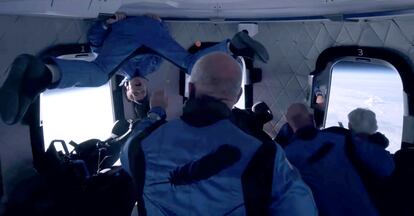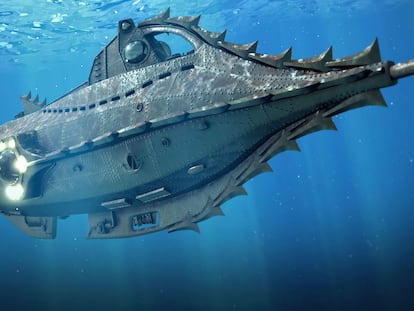Underwater dives and space flights: Off-the-beaten-path trips that only the wealthy can afford
Rich tourists are increasingly seeking out different experiences at prices ranging from $55,000 to millions of dollars


For some tourists, travel options do not end with the Earth’s surface. Trips up to space and down to the depths of the ocean are a growing trend in so-called elite tourism. They are reserved for the few who can afford them—prices for such adventures can range from $55,000 to $60 million — and are willing to accept some risks, as evidenced by last Sunday’s disappearance of a submarine carrying four tourists to explore the wreckage of the Titanic, located 3,800 meters down in the Atlantic Ocean. These are trips are at the pinnacle of exclusivity, the crème de la crème of the growing — and increasingly trendy — experience tourism industry where sensations prevail.
Observing the remains of the emblematic Titanic firsthand costs $250,000, according to OceanGate, the company that organized the excursions. The trip lasts seven days, but the key moment is the dive, which takes about eight hours (two and a half hours of descent, three hours on the seabed and another two and a half hours of ascent). As the company advertises on its website, the trip is made in a carbon fiber submersible that has space for five people, and it offers the “opportunity to get away from everyday life and discover something truly extraordinary.”
Since being discovered over 372 miles (600 kilometers) off the coast of Newfoundland, Canada, in 1985, the wreckage of the Titanic has attracted historians, archaeologists and curious people. Thanks to technology, the possibility of navigating a small submarine at shallow depths has attracted the interest of tourists. OceanGate (which also does dives to see other sunken ships) began offering this package in 2021. “It is striking that the Titanic continues to fascinate and create so much mystery,” says José Serrano, a professor at the European University of the Canary Islands in Spain and an expert on tourism. The traveler doesn’t seek experiences just to pursue adventures or personal challenges “but also to achieve a goal and brag about it, to show what they have accomplished,” Serrano adds. Thus, trips depend on the traveler’s budget: “Travel is a staple where the average person can choose from a few alternatives and people with a lot of money enjoy an increasingly unlimited catalog of options,” he adds.
Underwater tourism is emerging as a new category of experience. One of the projects presented in recent years has been Proteus, a version of the underwater International Space Station conceived by the French oceanographer Fabien Cousteau, popular oceanographer Jacques Cousteau’s grandson. The excursion is intended for researching the seabed, but there could also be tourist visits. Although no official rates are set, it is estimated that the starting price of a stay (between seven and 10 days and up to three months) could cost around €54,500.
Space travel
Such rates are not within everyone’s reach, but they are nowhere near as expensive as the prices that some millionaires pay to visit space. One of the best-known cases is that of 18-year-old Oliver Daemen, a Dutch student who, in July 2021, became the youngest person in history to travel into space. He flew alongside Amazon founder Jeff Bezos on the first manned flight of Blue Origin’s New Shepard spacecraft. His father paid an undisclosed amount for Oliver to experience weightlessness and gaze at the Earth’s curved horizon for a few minutes. He replaced an anonymous billionaire who bought the ticket for $28 million at a charity auction but later bowed out, citing scheduling problems.

A few months later, still in 2021, Russia launched Japanese billionaire Yusaku Maezawa and his assistant Yozo Hirano to the International Space Station, in a trip that marked Moscow’s return to the space tourism market for the first time in 12 years. “I believe that in a few years [spaceflight] will become more accessible, and our task now is to prove that all the obstacles can be overcome,” Maezawa explained before the flight.
Many companies are currently battling each other to see who can get the biggest slice of this new market, and the process is mostly in the experimental stage. World View is the most affordable option: it charges $50,000 for a balloon flight in the stratosphere. A few days ago, billionaire Richard Branson’s company Virgin Galactic announced that it will begin commercial operations in a few weeks, after 19 years of tests, accidents and technical challenges. Trips will cost between $450,000 and $600,000.
Founded by Bezos, Blue Origin began operating commercially in 2021. However, after seven flights, it had to suspend launches in September, following an unmanned rocket crash.
Elon Musk’s SpaceX has the most expensive prices on the market: in 2021, the company’s first private charter flight left Earth, bound for the International Space Station. Each of the three travelers paid $55 million for the ride and accommodation, including all meals.
“In many cases, experience tourism sells authenticity, something unique or local; it can be for people with more or less money, and part of that is for the elite. It is a growing trend, although I don’t think it has developed as much as expected yet,” says Pablo Díaz, a professor of Economics and Business Studies at the Universitat Oberta Catalunya (UOC) in Spain. Díaz gives the examples of helicopter tours to discover Andalusian gastronomy and people who book a room to stay in a former prison. It’s a new form of disconnection. “The reasons for traveling have been changing,” adds Serrano. “Since travel has been democratized, there’s the matter of status, differentiating [oneself] from what the majority is doing.”
People with a lot of money at their disposal are not satisfied with merely picking up a guidebook and choosing a couple of routes. Rather, they are seeking unique experiences selected by specialists who are familiar with the latest trends. Before starting their vacations, the wealthiest people can pay between $50,000 and $100,000 for someone to draw up luxurious travel plans, which might include rugged excursions in a desert followed by an air-conditioned luxury oasis. There are travel possibilities for all budgets. For example, an Everest expedition can cost between €80,000 and €100,000 for a person who doesn’t need to be a professional mountaineer and can get all the help they need during the expedition.
Sign up for our weekly newsletter to get more English-language news coverage from EL PAÍS USA Edition
Tu suscripción se está usando en otro dispositivo
¿Quieres añadir otro usuario a tu suscripción?
Si continúas leyendo en este dispositivo, no se podrá leer en el otro.
FlechaTu suscripción se está usando en otro dispositivo y solo puedes acceder a EL PAÍS desde un dispositivo a la vez.
Si quieres compartir tu cuenta, cambia tu suscripción a la modalidad Premium, así podrás añadir otro usuario. Cada uno accederá con su propia cuenta de email, lo que os permitirá personalizar vuestra experiencia en EL PAÍS.
¿Tienes una suscripción de empresa? Accede aquí para contratar más cuentas.
En el caso de no saber quién está usando tu cuenta, te recomendamos cambiar tu contraseña aquí.
Si decides continuar compartiendo tu cuenta, este mensaje se mostrará en tu dispositivo y en el de la otra persona que está usando tu cuenta de forma indefinida, afectando a tu experiencia de lectura. Puedes consultar aquí los términos y condiciones de la suscripción digital.
More information
Archived In
Últimas noticias
A survivor’s account of the Interoceanic Train accident: ‘We were scared because of the speed on the curve’
The Interoceanic Train, the Mexican alternative to the Panama Canal
What is known about the Interoceanic Train derailment in Oaxaca
Trump turns a Minnesota fraud allegation into ammunition for his MAGA army against Democrats
Most viewed
- Oona Chaplin: ‘I told James Cameron that I was living in a treehouse and starting a permaculture project with a friend’
- Reinhard Genzel, Nobel laureate in physics: ‘One-minute videos will never give you the truth’
- Why the price of coffee has skyrocketed: from Brazilian plantations to specialty coffee houses
- Pablo Escobar’s hippos: A serious environmental problem, 40 years on
- Chevy Chase, the beloved comedian who was a monster off camera: ‘Not everyone hated him, just the people who’ve worked with him’










































